Around this time of year, the garden is abuzz… not only with bees, butterflies and hummingbirds, but with the iridescent green, giant, flying beetles known as fig beetles (Cotinis mutabilis).
The first time I ever bumped into a fig beetle, literally, I actually heard it before I saw it coming. It sounded like a jumbo jet coming in for landing, and as I turned my head to look in its direction, one smacked me square in the head. It crashed at my feet, momentarily stunned but wiggling frantically on its back before finding its footing again and taking flight — swerving through the air like it’d had one too many tequilas.
Fig beetles are amusingly clumsy, and it’s a wonder they’re able to navigate at all. I’ve seen them crash into walls, poles, trees and people, but when they do make their target, they’re nestled deep in my fig tree, sucking the juice out of an over-ripened, dripping fig.
They don’t just go for figs though; they feed on pollen, nectar, and flower petals, but their favorites are fruits. They can’t bite into hard, immature fruits but love soft, squishy, super ripe fruits, especially those that have already been nibbled by birds.
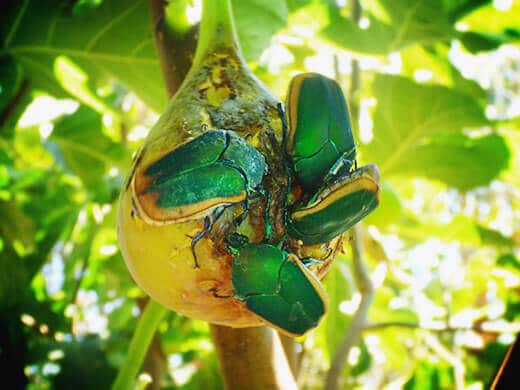

Fig beetles are also called figeater beetles or green fruit beetles, and are found throughout summer in the southwest (when the adults emerge from the larval stage). They look strikingly similar to and are sometimes confused with June bugs (Cotinis nitida, seen in the south) and Japanese beetles (Popillia japonica, native to Japan but brought to the east coast in the early 1900s).
I used to dread their appearance every summer but now I count the days when the fig beetles invade my garden… I actually leave a few of the rotting, dripping figs on my tree as a trap. Inevitably a handful of fig beetles will land on the fig and stay there all day, feasting. When I find them, I knock them down one by one into a jar — they’re often too full or too dazed to fly away.
But once they land inside the jar, they start buzzing furiously, climbing on top of each other and flipping over themselves.
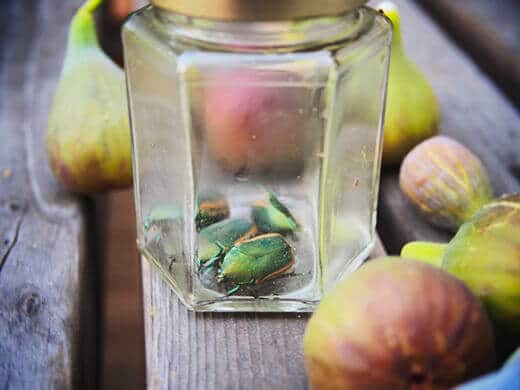
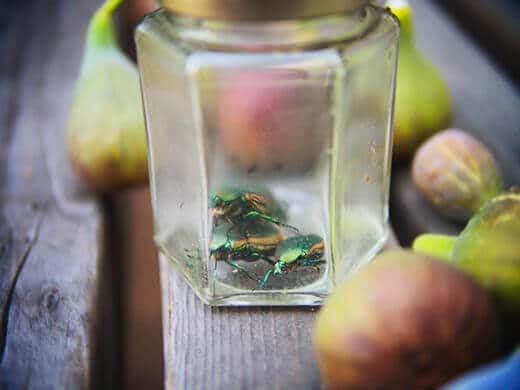
I think these two are trying to step up to me…
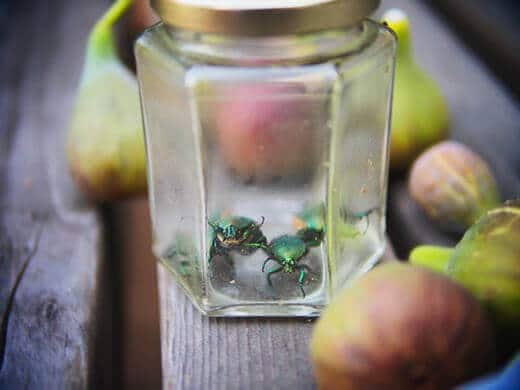
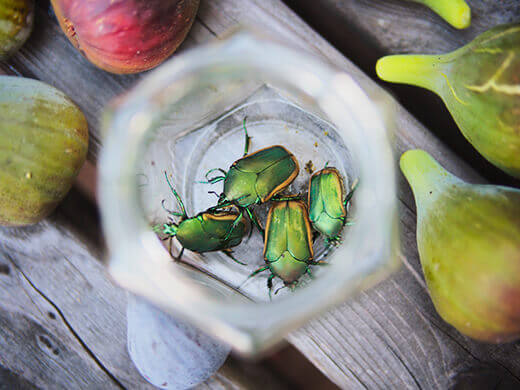
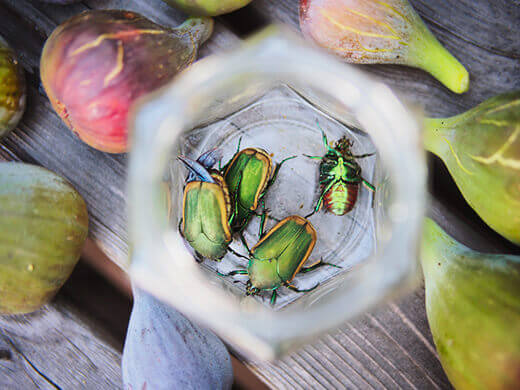
I collect as many as I can find, then make my way to the chicken coop where three very eager chickens run up to me, curious about the jar in my hand. I’ll even shake it around a bit to tease them. (Sounds savage, I know, but I’ve heard of people tying strings to fig beetles and flying them around like a kite, so this doesn’t seem quite as sadistic.)
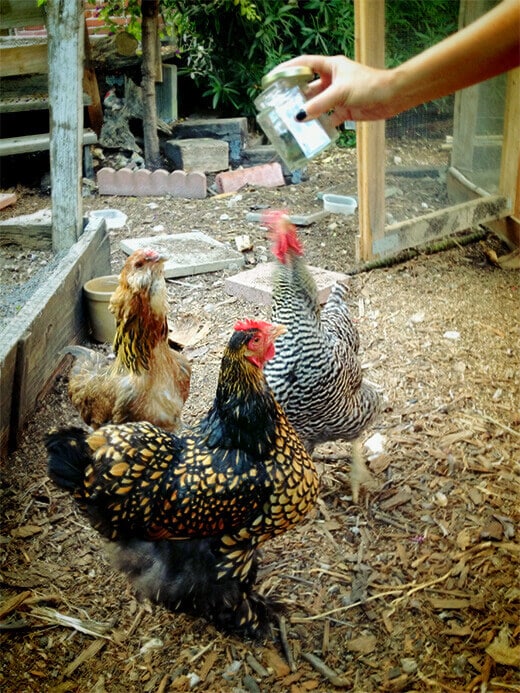
As soon as I take off the lid and drop the beetles to the ground, they’re gone faster than I can blink — into the beaks of my very satisfied chickens. I swear I’ve even heard them purr in satisfaction!


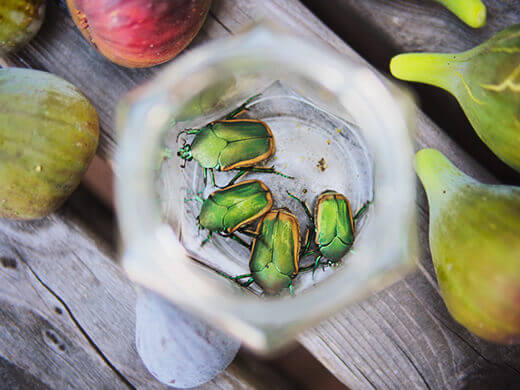













I found one in my living and I’m terrified I don’t want to go in there…
I think my cat ripped its head off cuz it’s missing
My M-I-L has a number of fig trees. These aggravating creatures are always swarming and many times land in clusters and swarm on the ground. I assume that free range chickens would aggressively pursue the beetles if allowed to roam around the area? Wonder if these can be lessened by using beneficial nematodes in the soil that attack insect larvae?
Chickens do love eating fig beetles, but they usually fly so high that mine can never catch them in the air. If yours has a tendency to swarm on the ground, then chickens would love to take care of that problem! 🙂
I am not sure about nematodes, but fig beetle larvae live in mulch and compost piles (where they feed off organic matter and hasten the decomposition process). You can bring them to the surface by turning your mulch and compost frequently in late winter to early spring, where they’ll likely die from exposure or get eaten by birds. You can also discourage them from landing on fruit trees by picking fruits as soon as they ripen. (Fig beetles are attracted to ripe and overripe fruit.)
haha what a sad day when they decide to land on your garden XD !
I forever thought that these massive creatures were Japanese beetles. I can vividly recall, as a child, these horrific beasts flying around and diving down at me as if I were an “all you can eat” buffet of fruit. These intimidating, behemoth animals have always, from day one, terrified me. Fig beetles are at the top of my “most feared insect” list, with the runner-up being the water bug. The color of these beetles are pretty to look at from the inside of the house looking outside through the window.
I still can’t touch one with my bare hands. The buzzing intimidates me! I have, however, knocked them out of the air onto the ground with my hands. Anything for my chickens!
I had always been told they are Japanese beetles as well. When I was a kid, we’d go after them with an old tennis racket. But now that I have a fig tree and it’s illegal to own chickens where I live in SoCal, I’m hunting for other viable solutions. It’s looking like Neem for immediate results and milky spore for a long term solution is the best way to go for me.
A tennis racket! Haha!
I would be happy to give these to my chickens if I had chickens. This year, I’ve had more than ever.
Oddly, we’ve had none this year! Maybe the birds are out-competing the fig beetles.
I collect them, just for the sake of their beauty. They die after they lay eggs beneath the leaves of our fig tree. Your chickens are gorgeous, BTW, though I couldn’t feed them such beautiful little creatures! I kind of hate how some people are scared of these harmless, beautiful bugs – they don’t bite, and they’re also the simple of resurrection and birth in Egyptian mythology.
SYMBOL. SYMBOL. How in the world did I type ‘simple’? That’s what you get for doing more than one thing!
Haha multitasking does it to me as well
I occasionally find their empty shells when I turn over the mulch in fall; I agree, their iridescence is beautiful.
Beware with chickens. I just wanted to share. When I was a kid we had a year where these beetles were everywhere. One afternoon with an apricot tree and a net, we filled a ziplock bag full of them. We then dumped out the entire bag into a 12 chicken coop. Over 50 beetles were picked up within seconds. After about 20 minutes a few of our hens started acting funny and 3 of them died. We did a home autopsy to find that beetles eaten in a rush were still moving and the sharp spines on the legs were causing internal bleeding in crop and gizzard. 1 or 2 beetles would probably never have caused this. Just wanted to share.
Thank you for sharing, and very good to know. With our flock, they’re so entertaining that we usually just feed a couple of bugs at a time so we can watch them. Our chickens will pretty much decimate the bodies before they swallow them, and I think that’s in their nature. I can see how an overexcited flock might swallow those bugs whole before breaking them apart.
Thanks Rick, that’s important and THE reason I logged on today, to find out of they can be safely fed to my chickens. I suppose just one or two–but fact is, in nature, all kinds of things can happen, from what happened at your place, to transmission of parasites; in nature, it is not all pretty as we know. Probably best to stick with properly prepared chicken feed–sure they will catch a cricket or beetle or what have you on occasion but probably best to not make a habit of collecting and feeding wild–anything really.
I’m in California too and I saw my first fig beetle last summer. I had never seen one before and it scared me so bad. And just like you describe, it bumped into something and stumbled around for awhile like it was drunk! Glad I finally know what this is!
Even though they’re harmless, they still startle me every time because of their sheer size and loud buzz! LOL
Do these beetles appear on the east coast? I just planted a fig on Martha’s Vineyard called ‘Chicago Hardy’ Had great fruit production the first year..Yum! Gonna check out that ginger recipe if I can get enough to harvest.
The east coast has a similar beetle called the Japanese beetle.
Awesome photography. Who knew fig beetles were so gorgeous?
soulobvious.com
RT @susandigsin: Moment of bug Zen No. 2 today: RT @theGardenBetty: Fig Beetles: Bumbling Pilots of the Garden http://t.co/tt6coZEUG2
They sound like jumbo jets coming in for landing! Fig Beetles: Bumbling Pilots of the Garden http://t.co/BL1XfqHSid #gardenchat #gardening
Moment of bug Zen No. 2 today: RT @theGardenBetty: Fig Beetles: Bumbling Pilots of the Garden http://t.co/V2bZbStt7W #gardenchat
RT @nativegardener: Fig Beetles: Bumbling Pilots of the Garden, by @gardenbetty .. http://t.co/LNgBZqnSL6 #insects #gardenchat
Fig Beetles: Bumbling Pilots of the Garden, by @gardenbetty .. http://t.co/LNgBZqnSL6 #insects #gardenchat
They’re clumsy, loud, and love to feast on your fruits. Fig Beetles: Bumbling Pilots of the Garden http://t.co/nD00O7rlpY #gardenchat
Some see them as pests; I see them as chicken treats. Fig Beetles: Bumbling Pilots of the Garden http://t.co/bSJtbhU1hf #gardenchat
Have these things crashed into you lately? Fig Beetles: Bumbling Pilots of the Garden http://t.co/M3h65FYU1T #gardenchat #gardening
How funny — I wasn’t expecting that bloodthirsty ending! When I lived in California I sometimes had giant hornworms on the tomato plants. I would pick them off and throw them to the chickens, who would throw them around and try to steal them from each other. We called it “hornworm football.”
LOL! My chickens do the same thing… One will find a tasty grub, only to have the other one pull it from its beak and run the other direction with it!
Gotta love the little ladies.
Hahahaha !
Urban Gardeners Republic liked this on Facebook.
The Horticult liked this on Facebook.
Kitchen Garden Maui liked this on Facebook.
Evette Garcia liked this on Facebook.
Cary Bradley liked this on Facebook.
I was erroneously calling them Japanese beetles. Hahahaha ! ” A rose by any other name “……tastes just as good to my chickens.
Besides sustainability with backyard chickens, people are really missing out on how fun our chickens can be. From that first race in the morning to the compost pile to grab the goodies and fig beetles that are an easy catch, to their jumping to grab one out of the air and then, a rousing game of keep away. It reminds me of a basketball game.
I used to call these Japanese beetles as well. I find a lot of them right before sunset, so the chickens now expect a little treat before bedtime! So spoiled.
These look identical to our Cotinus nitida, which can be found here in Ohio.
Love your photos!
BTW Americaunas do purr!
Yes, these guys are definitely familiar from our Whittier garden. I grew up in Montebello in a fig orchard and did not see them there, then. In the last 20 years, they definitely were in Whittier. An old pal of mine from work, a botanist, did tie strings to them when he was a kid in the 60s and fly them around, just like you say. Linda, don’t know if you’ve seen their larvae, but they are large, and were terrific at cultivating my compost heap. Loved them then, love them now. Cute guys! Glad your chickens enjoyed them! 🙂
The larvae freak me out! I’ve found them in my mulch, squirming around. I HAPPILY relocate them to the chicken coop!
Home Grown Edible Landscapes liked this on Facebook.
Fig Beetles: Bumbling Pilots of the Garden:
Around this time of year, the garden is abuzz… not only with bees… http://t.co/6J6Pv4pxYd
Blogged on Garden Betty: Fig Beetles: Bumbling Pilots of the Garden http://t.co/JR7M4HhKGq